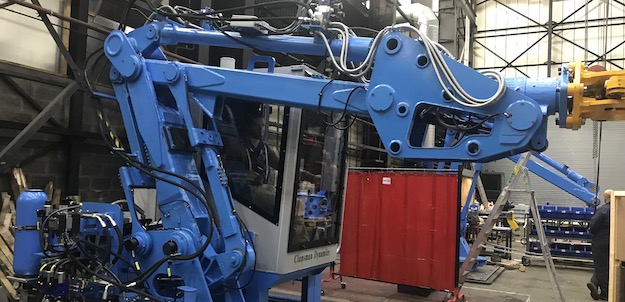
Staying on the Grind
By Tim Gessner
Fluid Power Machine BuildingElectrohydraulic motion controller gives “feel” to a grinding robot.

Clansman Dynamics of East Kilbride, Scotland builds complex robots systems designed to lift and move castings as well as manipulate grinding heads to smooth off imperfections from the casting process.
Chief among those technologies is the design and construction of state-of-the-art robotic systems. Clansman robots lift and move castings as well as manipulate grinding heads to smooth off imperfections that result from the casting process. The robots are hydraulically powered to carry or exert heavy loads, and survive in harsh environments that involve a lot of external forces and vibrations.
Before the advent of robotic solutions, operators could manually operate the grinding wheels for only so many hours per day, limiting productivity and factory output. A difficult and demanding task, Clansman saw an opportunity to automate the process with a robotic grinding solution, but they needed a way to supply their robots with force feedback, the “feel” that guided the work of human grinding operators. Without reference to this feedback, an operator attempting to push the grinding head only a millimeter or two too far into the casting could result in damage to the part under the full force of the machine.
The need for flexibility
Most of the company’s standard robots use Clansman-designed analog electronics for motion control, as the advanced functionality of a programmable electrohydraulic motion controller is not required. The downside of this is that analog controllers lack flexibility.
To add the flexibility of programmable control, Clansman has used Siemens and Rockwell PLCs with hydraulics interface cards, but they still needed their own custom circuits to provide the necessary pressure feedback. More recently, the company has started using a programmable multi-axis electrohydraulic motion controller from Delta Computer Systems in some of its more complex applications.
Complex motion challenges
What makes some of Clansman’s applications complex is that many of the axes have to seamlessly transition from tracking the motion of a control arm to following a computed trajectory. It then has to transition to maintaining force control. Finally, the control arm itself is controlled by the RMC and transitions from closed-loop to open-loop control, all the while feeling smooth and intuitive to the operator.
“The complexity is increased by the fact that our machines feature long booms with heavy loads at the end of them and relatively small cylinders, which results in axes with very low natural frequencies,” Watson explained.

To control the hydraulically actuated force feedback axes on the control arm of its robotic systems, Clansman Dynamics’s turned Delta Computer Systems’ RMC150 controller.
“The important things we needed from the motion controller were the ability to make very fine adjustments to position while keeping the force applied by the grinder at a reasonably low value,” said Richard Watson, a Clansman controls engineer. “Doing this manually, without a significant amount of practice, is very difficult, especially when working on rough surfaces.”
Selecting a motion controller
Following online research into motion controllers, Watson selected Delta Computer Systems’ RMC150. “It has built-in functions for active damping,” he said. “I also liked the fact that control loop gains can easily be changed on the fly. That’s important because the booms of the machine move around pivot points and the required gains of each axis motion equation vary a lot depending on the current position of that axis.”
“The instruction set of the RMC is also much larger than the PLCs for controlling motion,” Watson added. “In particular, the Track Position command supported by Delta’s RMC controllers, which allows the following of a joystick master with velocity and position limits, works well with our manual controls. This enables us to use our standard control arm, which is much more intuitive to use for machine operators.”
“I also like the fact that Delta’s RMCTools support software is fast and freely available,” said Watson. “I really like how fast the development process can be – you can move the axes with direct commands immediately to validate the hydraulic circuits.”
Watson uses Delta’s Tuning Wizard software to get the control loop parameter gains close to optimal, and then manually fine tunes the system to get the active damping running properly.
“I have been very impressed with the capabilities of the RMC,” concludes Watson. “The development time is short compared to other solutions we have tried and the flexibility allows us to quickly add new features to meet our customers’ individual requirements.”
https://deltamotion.com
Tim Gessner is Director of Business Development, Europe at Delta Computer Systems Inc.
